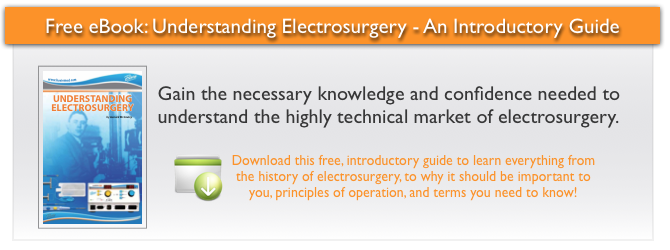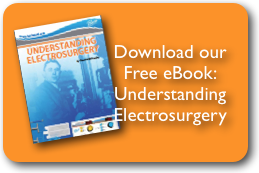 Do you perform electrosurgical procedures in your family practice office? No, we’re not talking about electrocautery. Electrocautery in medical terminology is often misused as a synonym for electrosurgery, even by medical professionals. Don’t confuse electrocautery with electrosurgery.
Do you perform electrosurgical procedures in your family practice office? No, we’re not talking about electrocautery. Electrocautery in medical terminology is often misused as a synonym for electrosurgery, even by medical professionals. Don’t confuse electrocautery with electrosurgery.
Electrocautery can be confidently used for several in-office procedures, even with patients who have implanted electrical devices (pacemakers, cardio-defibrillators, etc.). Many physicians call a battery-operated instrument their “Bovie Cautery,” and if the Bovie® name is on the instrument, they are correct. Most cauteries do their work by creating temperatures in the neighborhood of 2200° F; lower temperatures are used for procedures that require fine detail, such as ophthalmologic, for example.
Electrosurgery doesn’t work the same way; there’s no heat involved in the process at all. Instead, a high-frequency electrical current works to dehydrate (desiccate) and cut tissues, and to coagulate them at the surgical site. Until recently, electrosurgery procedures were reserved for surgeons; one of the reasons was that it produces electromagnetic interference with implanted medical devices, which primary care physicians have found intimidating (to say the least). Many physicians felt they had not been properly trained. But with changes within the healthcare industry, family practitioners are stepping up to the plate and expanding their in-office procedures to include electrosurgery.
How electrosurgery is used
As we have explained before (Key Differences: Electrocautery and Electrosurgery), there are two primary methods of employing electrosurgery: monopolar and bipolar procedures:
In order to properly perform monopolar electrosurgery, a complete electrical circuit is required which consists of the electrode, patient, return electrode (grounding plate) and the electrosurgical generator (ESU). With the monopolar technique, the electrical current travels from an electrode through the patient until it reaches a grounding pad (return electrode) placed in proximity on another location on the patient's skin, most typically on the opposite side of the body from the incision and then the energy returns to the generator.
The bipolar technique utilizes a forceps-style electrode, which acts as the electrode and return-electrode . . . the electrical current travels from one tip to the other, with the targeted tissue placed between them. . . . Monopolar uses a grounding plate to direct the current, while bipolar employs opposing electrode points to accomplish the same thing.
Electrosurgery can be used for minor outpatient surgical procedures using a local anesthetic in the office. Some such cases include:
-
Cosmetic and skin care
-
Angiomas, cherry angiomas, pyogenic granulomas
-
Scar reduction
-
Telangiectasia
-
-
Gynecological – Vaginal and hysteroscopic procedures
-
Ocular – Chalazion removal
-
Dermatological – Remove skin lesions
-
Acne treatment
-
Basal cell carcinomas (< 0.2" diameter)
-
In situ squamous cell carcinoma
-
Seborrheic keratoses
-
Skin tags
-
Warts
-
-
Urological – Routine penil procedures
-
Circumcision
-
Penoscrotal fusion/chordee repair
-
Download our free Bovie Literature and Training Materials today. For decades, Bovie Medical has been the flagship for state-of-the-art electrosurgical products and accessories. Like most medical professionals, we continue to study the latest technologies and patient care innovations that will enhance the quality of life for many. If you have any questions or comments, please contact us or call toll-free 800-537-2790 (international call 1-727-384-2323).
Image courtesy via: holohololand/freedigitalphotos.net




